Effective Strategies for Safely Removing a Bird Indoors
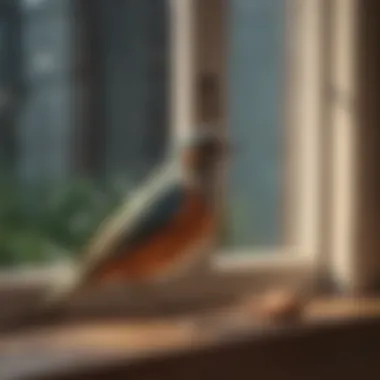
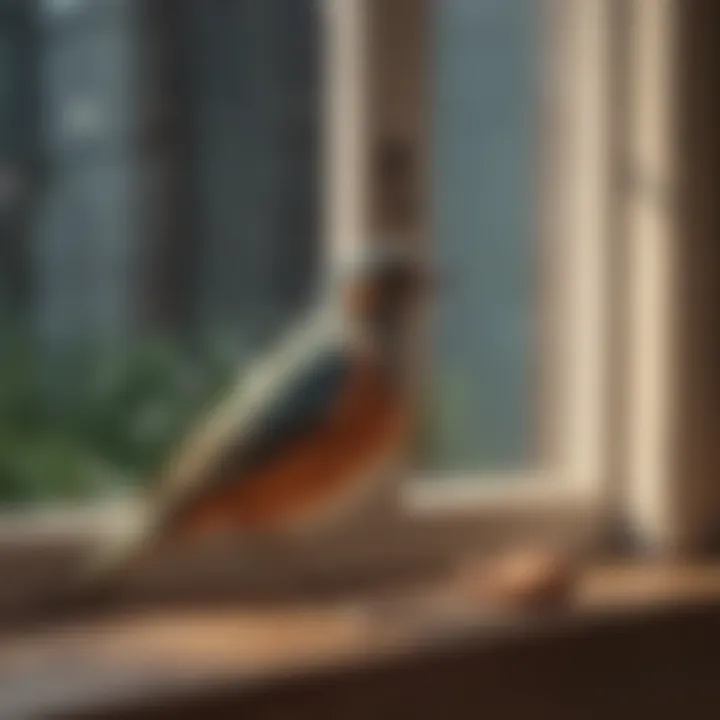
Intro
Removing a bird from an indoor space can be a delicate task. Understanding the specifics of your avian companion is crucial. A calm and calculated approach helps ensure the safety and well-being of both the bird and the person attempting the removal. This article outlines strategies to manage such situations effectively, focusing on preparation and careful methods.
Understanding Your Pet
Before initiating the process of guiding a bird outside, it is essential to comprehend basic pet behavior. Birds are sensitive creatures, often affected by their environment. Recognizing common traits in your bird can aid significantly in managing its behavior while in confined spaces.
Pet Behavior Basics
Birds instinctively react to perceived dangers and unfamiliar situations. Their flight responses can often lead them to panic, which can complicate the removal process. Understanding the signals your bird displays can be beneficial. For example, flapping wings, open beak, or a crouched position could indicate stress. Responding to these cues calmly helps minimize additional stress.
Common Breed Characteristics
Different bird species exhibit unique behaviors. For instance, parrots may be more social and curious, while doves tend to be more docile. Familiarizing yourself with the characteristics of your bird's breed helps in formulating a tailored approach. Knowing whether your bird responds positively to gentle coaxing or requires a more unobtrusive method can influence your strategy.
Species-Specific Needs
Different species require particular attention when attempting to guide them outdoors. For example, parrots often respond well to treats, while finches may prefer a more indirect approach. Assessing these preferences forms the foundation for an effective removal strategy that is stress-free for the bird.
Preparing for the Removal Process
Preparation is critical when considering how to remove a bird from an indoor setting. A well-thought-out plan reduces potential complications.
Assessing the Space
Before attempting to remove a bird, take stock of the room. Close doors and windows to prevent the bird from flying into them. If possible, turn off artificial lights and opt for natural lighting, as this may encourage the bird to move towards the exit more comfortably.
Creating a Safe Exit
Make the exit as inviting as possible. Open the door leading outside wide enough to avoid blockage. If possible, position a perch or flat surface near the door, as this may attract the bird’s attention and encourage it to leave on its own.
Methods for Encouraging the Bird to Exit
When ready to guide the bird from your space, there are various techniques to consider.
Gentle Coaxing
Employing gentle sounds and soft movements can encourage the bird to explore outside. Using a soothing voice and mimicking sounds of their flock can be effective. A slow hand movement can also provide opportunities for the bird to feel secure while navigating towards the exit.
Using Food as Incentive
Offering favorite treats can be helpful. Positioning the food at the exit might encourage the bird to fly towards it. Remember to stay calm and patient during this process.
Patience is key when interacting with birds. Quick movements or loud noises can agitate them further, complicating the situation.
Safety Precautions
Both the individual and the bird’s well-being must be a priority.
Protective Gear
While not always necessary, wearing gloves can provide protection during the interaction, particularly if the bird becomes defensive.
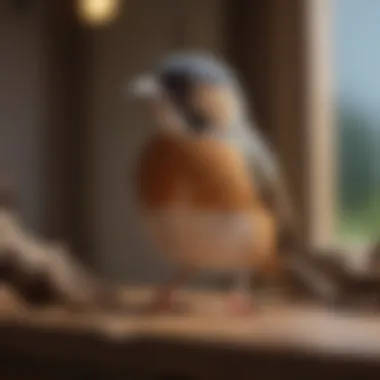
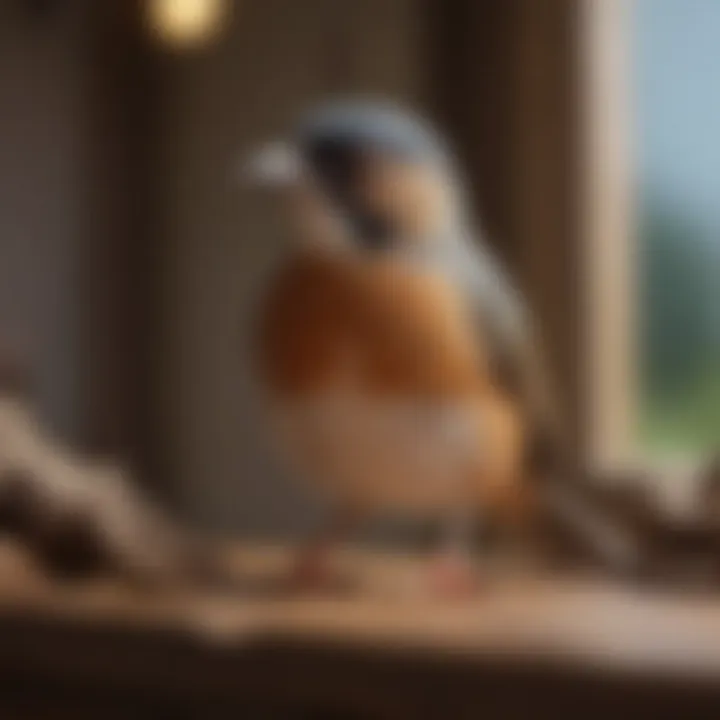
Maintaining a Calm Atmosphere
Ensure that any human presence maintains a serene demeanor. This can reduce stress levels for the bird, which is integral for a smooth removal.
The End
In summary, safely removing a bird from an indoor space involves understanding its behavior, preparing the environment, employing methods of encouragement, and taking safety precautions. When approached with care, this experience can be managed effectively, ensuring that both the bird and the individual remain calm and content.
Preface to the Issue of Indoor Birds
Birds can sometimes find their way into homes and buildings, creating unique challenges for residents. Understanding how to effectively remove these birds isn't just about getting them out but also ensuring their well-being. Many people encounter this scenario when a bird accidentally flies in through an open door or window. Such situations can be stressful for both the occupants and the bird, emphasizing the need for a careful approach.
The importance of addressing the issue of indoor birds lies in the recognition that these creatures have unique behaviors and needs. Many pet owners and animal lovers may not be aware of how to respond when a bird ends up inside their space. Their instinct to flee can lead to panic, making it crucial to manage the situation with care. Using effective strategies not only facilitates the bird’s safe exit but also reduces their stress levels.
Additionally, understanding the potential types of birds that may venture indoors can inform the removal process. Each species exhibits different behaviors, requiring tailored approaches. Recognizing this enhances the potential for a peaceful resolution for all parties involved. By approaching this topic systematically, we can ensure a safe experience, both for the birds and the humans who encounter them.
Understanding the Behavior of Birds
Birds are complex creatures with instinctive behaviors that often dictate their reactions in unusual situations. When trapped indoors, their natural responses include flapping, darting, and seeking refuge in corners or high places. This behavior can be exacerbated by stress, leading them to crash into walls or windows in an attempt to escape.
Being attuned to these behaviors can assist anyone in creating a minimal-stress environment for the bird. Understanding that they might not recognize exit routes or may feel threatened is essential. The more you observe these traits, the better equipped you will be to coax them toward an exit without inducing further panic.
Common Types of Birds Found Indoors
Several species of birds are commonly found in indoor spaces, either by accident or due to their curiosity. Among these, some of the frequent visitors include:
- Sparrows: These birds are small, agile, and can easily enter homes through open spaces.
- Starlings: Known for their gregarious nature, starlings often flock together and can become disoriented indoors.
- Pigeons: Although less common than smaller birds, pigeons can accidentally get inside, especially in urban areas utilizing balconies or windows.
Being aware of the typical birds one might encounter helps in determining the best course of action for removal. Each bird type comes with its distinct traits and habits that, when understood, greatly improve the process of safely guiding them outside.
Preparation Before Attempting to Remove the Bird
Preparing to remove a bird from an indoor area is essential for ensuring a smooth and humane process. Taking the right steps beforehand can greatly reduce stress for both the bird and the person attempting the removal. This stage is about careful planning and being aware of the environment.
Ensuring a Calm Environment
A calm environment sets the stage for a more successful attempt at removal. Birds are sensitive creatures; any sudden movements or loud noises can cause panic. It is vital to minimize disturbances. Turn off distractions, such as televisions or loud music. If possible, gently dim the lights in the room. This may help soothe the bird.
Also, try to keep pets away from the area. The presence of other animals can create additional stress. Keeping the area quiet and peaceful can encourage the bird to feel safe enough to exit on its own.
Assessing the Bird's Location
Knowing exactly where the bird is positioned can inform the strategy for removal. Observe the bird's behavior from a distance before making any attempts. Look for signs of where it frequently perches or rests. This provides insight into its comfort zones and potential exit routes. Understanding its environment helps in deciding the best method to encourage it to leave.
Additionally, assess any obstacles in the room. Identify items that may hinder the bird’s exit path. Removing or clearing these items can create a more inviting atmosphere for the bird to escape.
Gathering Necessary Tools
Having the right tools can make the removal process more effective. Here are the main tools you might need:
Netting Options
Netting options can be effective for safely capturing a bird without causing harm. These nets are specifically designed for animal handling and are often lightweight yet durable. They allow for a gentle approach when trying to catch the bird. A unique aspect of netting options is their ability to minimize stress on the animal. However, it is crucial to choose the right size to avoid entrapment. While effective, using a net may require some skill to ensure the bird is captured safely.
Cardboard Box

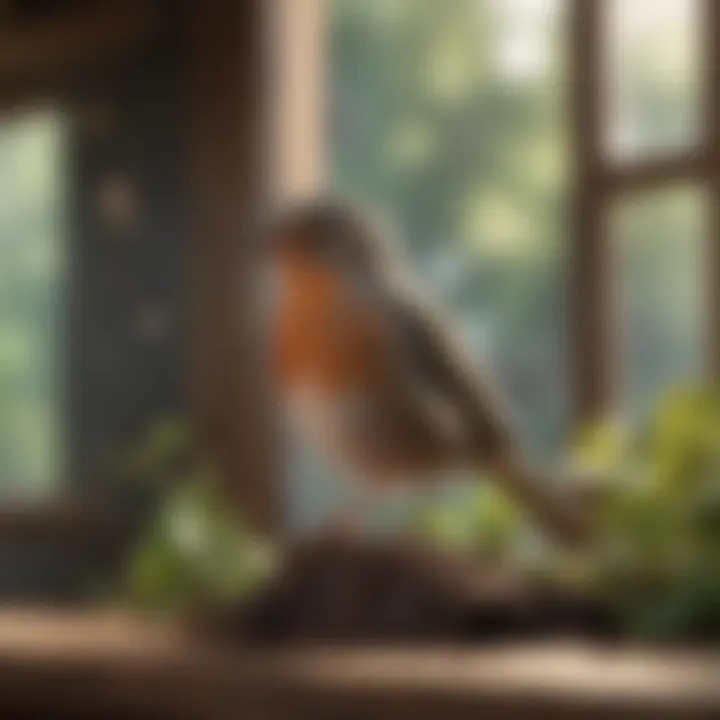
A cardboard box is an excellent tool for containing the bird once it has been caught. It is lightweight and easily accessible, making it a practical choice. This option offers a temporary shelter for the bird until it can be safely released outdoors. A unique feature of a cardboard box is its simplicity; it can be easily modified to include ventilation holes. However, it’s essential to ensure that the box is sturdy enough to prevent escape. The disadvantage is that it does not offer visual cues for the bird, which could increase its anxiety.
Food as Bait
Using food as bait is one of the most straightforward strategies for encouraging a bird to exit. Birds are generally attracted to food, making this method potentially effective. Identifying the type of food the bird prefers is essential. Whether it’s seeds or fruits, offering its favorite food can create an inviting scenario. The key characteristic of this approach is its non-invasive nature. However, remember that it may not always work quickly. In some cases, patience is necessary as the bird may take time to feel comfortable enough to approach.
Preparation is the first key step to ensure a safe and stress-free bird removal experience. Without it, subsequent efforts may be hampered.
Methods to Encourage a Bird to Exit
Encouraging a bird to exit from an indoor space is a pivotal step in the overall process of safe removal. It is crucial to help the bird find its way out without causing excessive stress. This section elaborates on several effective methods—each method tailored to take into account the bird's natural behavior and instincts. The strategies discussed will not only facilitate a smooth exit but ensure the safety and comfort of both the bird and the individual involved.
Creating Exit Points
Creating exit points is a simple yet effective strategy for encouraging an indoor bird to leave. By opening optimal routes for the bird, you decrease barriers that could prevent its escape.
Opening Windows
Opening windows serves as a primary technique in creating exit points. This method works well for various species, as birds often instinctively fly toward openings. The key characteristic of opening a window is immediate accessibility. Many windows are designed for easy use, making them suitable for creating a pathway for the bird to exit. One unique feature is that you can open a window partially or fully, depending on the bird's size and behavior. The main advantage of this option is that it typically offers a direct escape route without complicated barriers. However, there's a disadvantage; if the window is too high, the bird may be reluctant to jump out, potentially leading to hesitation.
Doors to Allow Free Passage
Another effective method is using doors to allow free passage. Opening a door can provide a wider exit point, which can be especially helpful for larger birds. The key characteristic here is the spaciousness of the opening. This choice is beneficial as it minimizes the risk of the bird injuring itself while trying to exit. A uniquely crafted design of doors, especially those with screens or open sections, increases visibility and encourages the bird to fly out. However, one disadvantage lies in the possibility that other entities, like pets or children, may also venture through the open door, posing a safety risk for the bird during the exit process.
Using Light and Sound to Attract the Bird
Light and sound are influential factors in attracting a bird. Birds are generally drawn to brightness. Opening curtains or utilizing bright lights can guide them toward the exit points. Moreover, soft sounds can create a welcoming atmosphere. Playing gentle music or mimicking bird calls might encourage the bird to move toward the open window or door. However, care should be taken to adjust the sound levels, as loud noises may create panic.
Utilizing Food as an Incentive
Using food as an incentive can be particularly effective in persuading a bird to exit. Birds are generally motivated by food. Placing an appealing morsel near the exit points can lure them to the openings. Both seeds and fruits often work well in this scenario. The advantage lies in utilizing their natural instincts to seek food. Yet, one must be mindful not to create a dependency on human-provided food, as this could alter their behavior in the long term.
By strategically implementing these methods, one can significantly increase the likelihood of a bird exiting an indoor space safely and efficiently. Understanding the natural tendencies of birds while incorporating light, sound, and food can create an inviting atmosphere that promotes a quick and stress-free exit.
Safety Precautions During the Process
When faced with the task of removing a bird from an indoor space, understanding safety precautions is crucial. These measures not only protect the bird but also ensure the safety of individuals involved. It is essential to approach the situation with care, as stress or mishandling can lead to harm for both parties. Proper precautions can make the removal process smoother and more effective, thereby preventing unnecessary distress for the bird and potential hazards for humans.
Minimizing Stress for the Bird
Birds, like many animals, react poorly to stress. The experience of being trapped indoors can already be frightening for them. Minimizing this stress is essential for the health and well-being of the bird. Here are some strategies to create a calmer environment:
- Limit Loud Noises: Keep noise levels down. Sudden sounds can cause panic in birds.
- Reduce Movement: Avoid fast movements that may startle the bird. Slow and gentle actions can help.
- Close Off Rooms: Restrict access to other rooms, creating a smaller space for the bird to feel secure.
- Dim Lighting: Keeping lights dim can be less intimidating for the bird.
These measures may encourage the bird to feel more at ease, increasing the chances of a successful exit without panic.
Protecting Yourself and Others
While focusing on the bird’s safety, it’s also vital to consider the well-being of yourself and those around you. The unexpected nature of a trapped bird can lead to stressful situations. Here are specific steps to maintain safety during this process:
- Wear Protective Gear: Depending on the bird's behavior, consider wearing gloves. This can prevent potential scratches or bites.
- Keep Pets Away: Ensure that any pets are secured in another area. Their presence can increase stress for the bird and lead to unpredictable behavior.
- Remain Calm: Your demeanor affects the bird’s behavior. Staying calm can prevent agitation of the bird and create a safer environment.
- Have a Plan: Prepare a clear strategy for the removal process. Knowing the next steps can reduce uncertainty and chaos.
Taking these precautions ensures that while aiding the bird, you also maintain a secure atmosphere for yourself and others in the space. Effective bird removal is achievable with attentiveness and care.
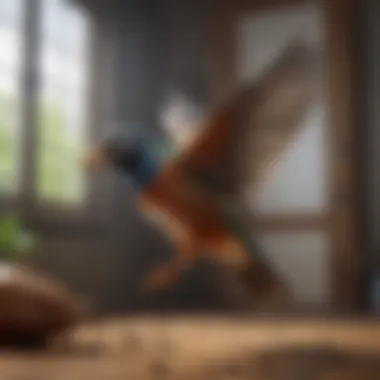
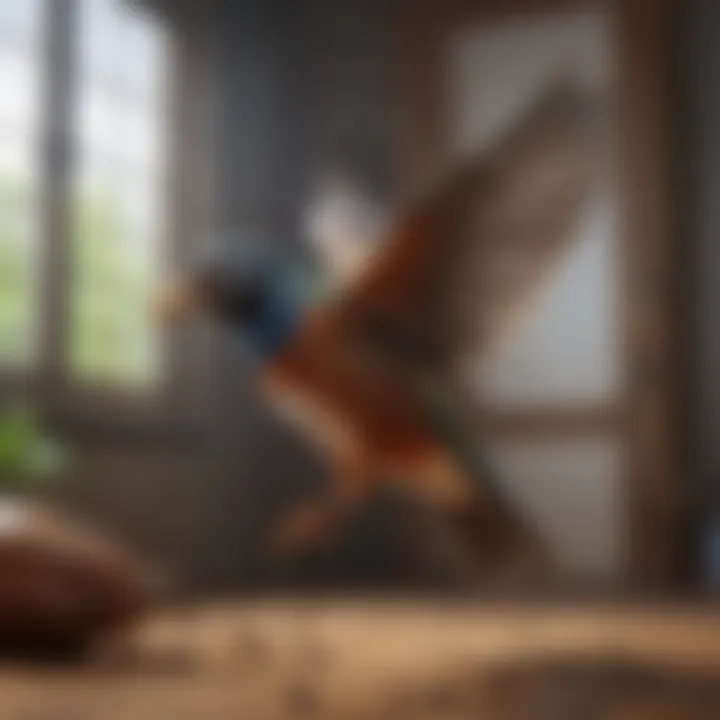
Handling Situations Where the Bird is Aggressive
Handling bird removal can become complex when the bird exhibits aggression. Recognizing and properly managing aggressive behavior is crucial. This ensures the safety of both the individual trying to assist and the bird itself. An aggressive bird may feel threatened, leading it to act defensively. Understanding its behavior can guide you in taking appropriate measures. This section will cover how to identify signs of aggression and present strategies for safe capture.
Recognizing Aggressive Behavior
Birds can display aggression due to fear or stress. Key signs of aggressive behavior include:
- Glaring Stares: A bird may fixate on you with a hard stare. This is a warning sign that it feels threatened.
- Wing Flapping: Rapid wing movement can indicate agitation. This behavior is often accompanied by loud calls.
- Beak Open: If the bird opens its beak wide, it may be preparing to bite. This is a strong indication of aggression.
- Loud Vocalizations: Unusual, loud squawking can serve as a warning. The bird is expressing its discomfort or fear.
Understanding these behaviors is essential. If you notice any of these signs, it’s best to approach the situation with caution. The goal is to make the bird feel secure while also protecting yourself from potential injury.
Strategies for Safe Capture
When an aggressive bird poses a challenge, employing specific strategies for capture is necessary. The following methods can aid in facilitating a safe and effective capture:
- Calm Environment: Lowering noise and removing distractions can make the bird feel more secure. It may help reduce its aggressive tendencies.
- Use a Protective Barrier: Items such as cardboard can create a barrier between you and the bird. This can reduce the risk of injury.
- Gentle Approach: Move slowly and gently. Quick movements may provoke the bird further.
- Distraction with Food: Place food in the vicinity of the exit point. This can coax the bird without confrontation.
- Capture Net: If absolutely necessary, a net can be used as a last resort. Approach from above, minimizing the risk of harming the bird.
Always remain aware of your surroundings. Your focus should be on the bird’s behavior while ensuring your safety. This precaution will help manage a situation where handling an aggressive bird is unavoidable.
Post-Removal Considerations
Post-removal considerations are crucial when dealing with a bird that has been safely extracted from an indoor environment. The actions taken at this stage can significantly impact the bird's well-being and survival in its natural habitat. By being mindful of specific elements and actions, you contribute to a safer transition for the bird while enhancing your understanding of the overall process.
Ensuring the Bird's Safety Outdoors
After successfully removing the bird, it is essential to ensure its safety outdoors. This involves identifying a suitable location where the bird can acclimate before flying away. Ideally, choose a spot that is quiet, away from heavy traffic, and free from potential predators.
Key points to consider include:
- Time of Day: Releasing the bird during daylight hours increases its chances of finding food and shelter.
- Weather Conditions: Check the weather before releasing. Avoid releasing birds during storms or extreme temperatures.
- Natural Habitat: If possible, return the bird to an area close to where it was found to help it reorient itself.
In addition, observe the bird's behavior after release. If it appears disoriented, give it time to adjust. It may take a moment before it decides to fly away or move.
Checking for Injuries or Distress
Before and after the bird's release, checking for any signs of injuries or distress is essential. Observing the bird can reveal indicators of its health and overall well-being.
Signs to look for include:
- Limping or difficulty standing: This may suggest an injury that requires attention.
- Feather condition: Disheveled or missing feathers can indicate stress or injury.
- Behavior differences: If the bird shows reluctance to fly or appears unusually calm, it could be an sign of distress.
If signs of distress or injury are present, it may be necessary to seek assistance from a local wildlife rehabilitator or veterinarian. They have the experience and resources to evaluate and treat the bird appropriately.
Being proactive in ensuring a bird's safety and checking for injuries should be a priority after removal.
In summary, post-removal considerations enhance the likelihood of a successful transition for the bird back into the wild while providing peace of mind for those involved in the process.
The End
In this article, we explored the intricate process of safely removing a bird from indoor spaces. Understanding the balance between human intervention and the bird's natural instincts is crucial. Removing a bird without causing stress or harm requires thoughtful preparation and execution.
Final Thoughts on Bird Removal
It is of utmost importance to approach bird removal with patience and care. Birds, like any other living creatures, can experience anxiety. When we create calm environments and allow for safe exit routes, we foster a more harmonious relationship between humans and wildlife.
Practicing these effective strategies not only benefits the bird but also ensures that you feel confident and secure in your approach. Remember to always observe the bird's behavior, and recognize that each situation is unique.
Some key considerations include:
- Staying calm yourself, as birds can pick up on your stress.
- Monitoring the bird's health and well-being post-removal.
- Being prepared with tools and techniques that ensure a safe capture.
In summary, the gentle art of bird removal is about respect for the life you are dealing with. While it may appear daunting at first, working through the methods discussed brings peace of mind. The goal is to allow the bird to return to its natural environment without distress or injury, enhancing a respectful coexistence between us and the avian world.







